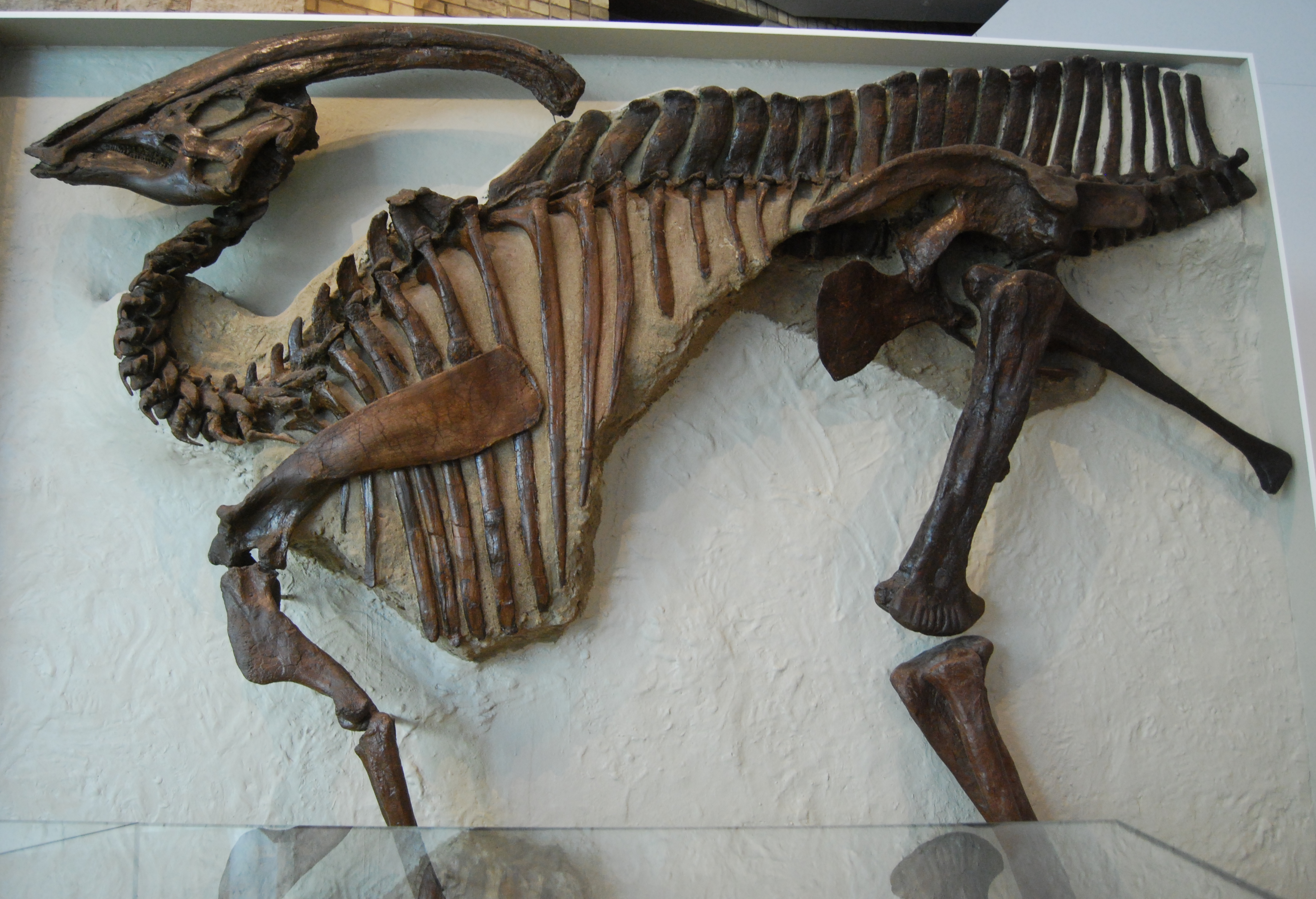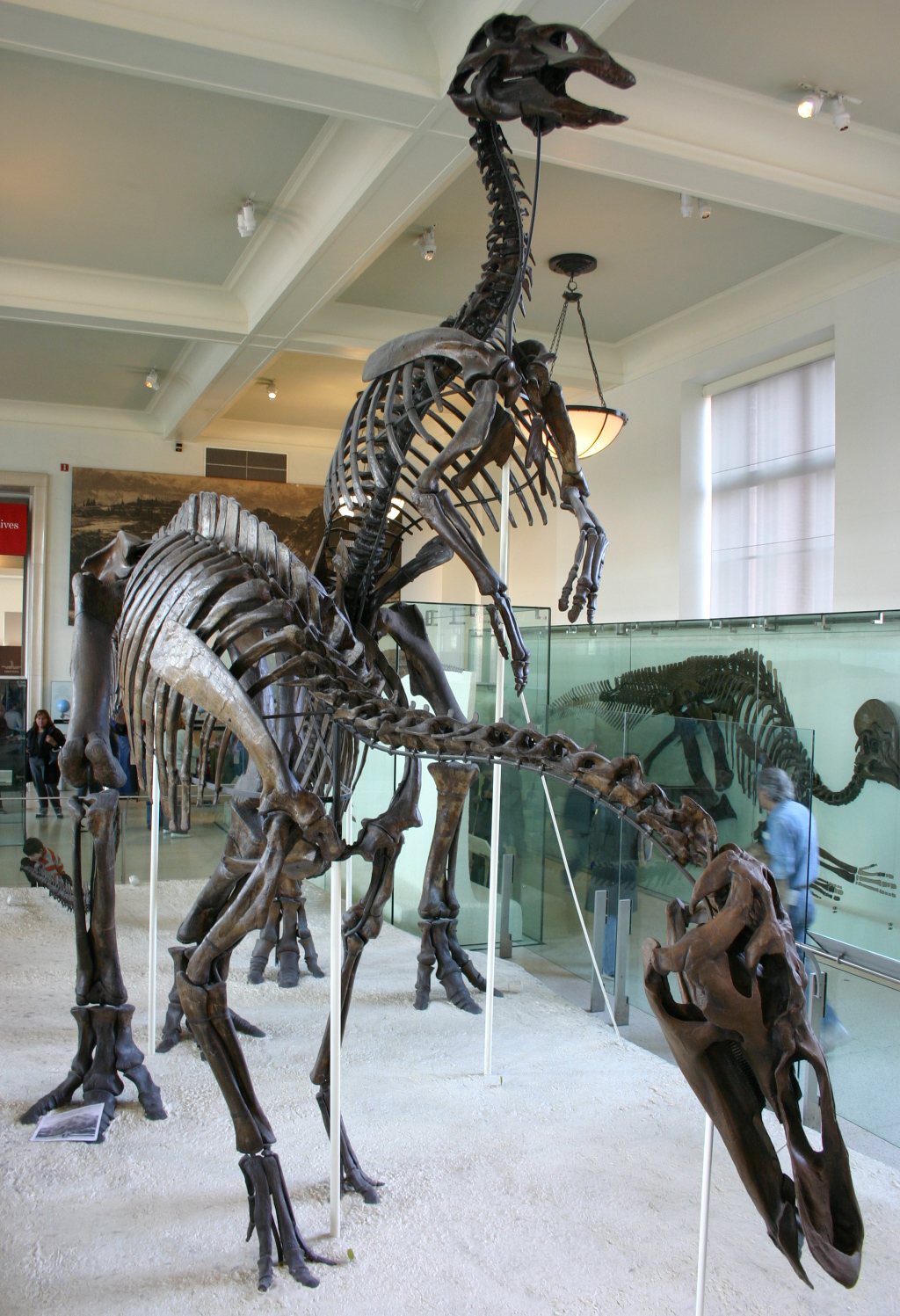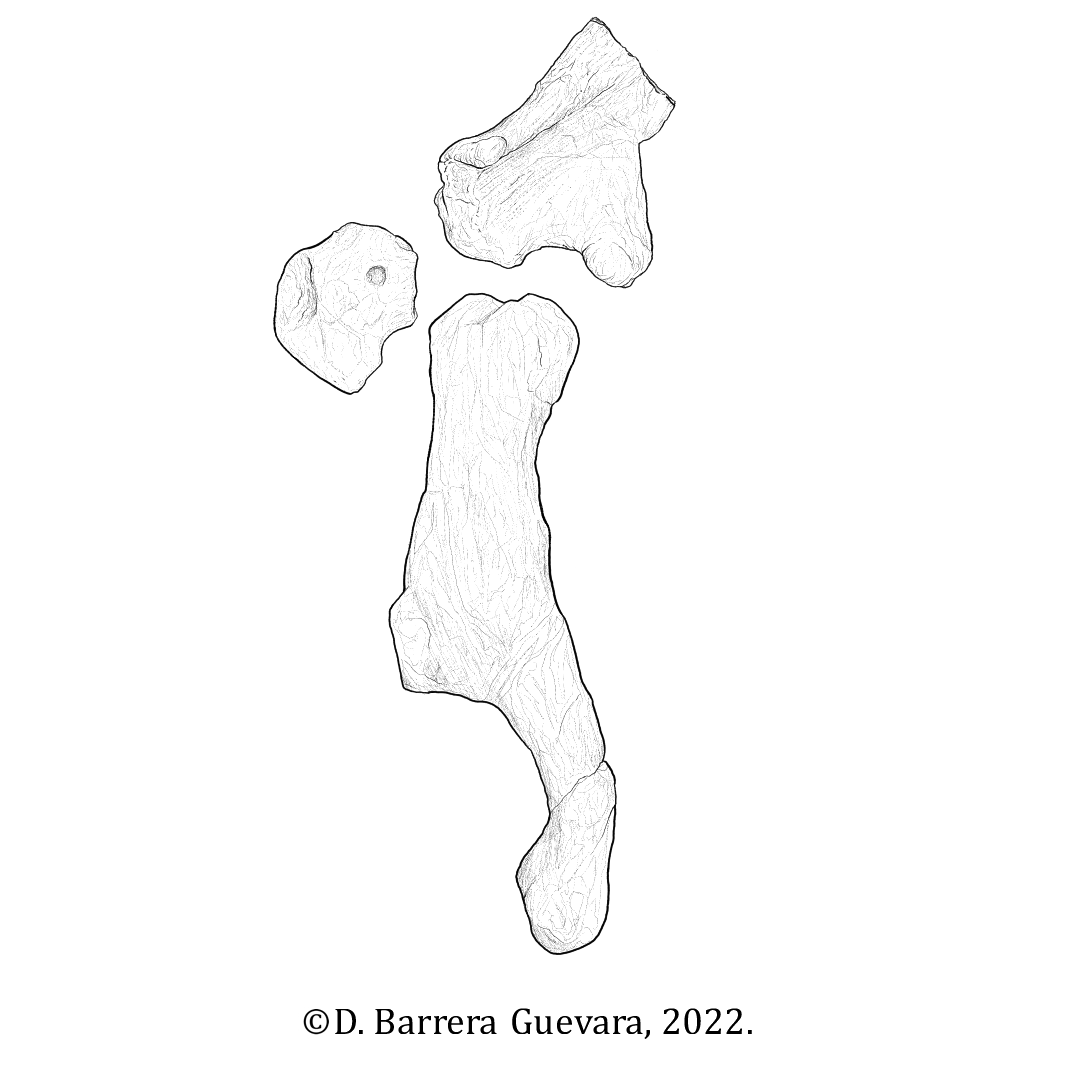|
Hadrosaurid
Hadrosaurids (), or duck-billed dinosaurs, are members of the ornithischian family Hadrosauridae. This group is known as the duck-billed dinosaurs for the flat duck-bill appearance of the bones in their snouts. The ornithopod family, which includes genera such as ''Edmontosaurus'' and '' Parasaurolophus'', was a common group of herbivores during the Late Cretaceous Period. Hadrosaurids are descendants of the Upper Jurassic/Lower Cretaceous iguanodontian dinosaurs and had a similar body layout. Hadrosaurs were among the most dominant herbivores during the Late Cretaceous in Asia and North America, and during the close of the Cretaceous several lineages dispersed into Europe, Africa, South America and Antarctica. Like other ornithischians, hadrosaurids had a predentary bone and a pubic bone which was positioned backwards in the pelvis. Unlike more primitive iguanodonts, the teeth of hadrosaurids are stacked into complex structures known as dental batteries, which acted as effectiv ... [...More Info...] [...Related Items...] OR: [Wikipedia] [Google] [Baidu] |
Edmontosaurus
''Edmontosaurus'' ( ) (meaning "lizard from Edmonton") is a genus of hadrosaurid (duck-billed) dinosaur. It contains two known species: ''Edmontosaurus regalis'' and ''Edmontosaurus annectens''. Fossils of ''E. regalis'' have been found in rocks of western North America that date from the late Campanian Stage (stratigraphy), stage of the Cretaceous Period (geology), Period 73 million years ago, while those of ''E. annectens'' were found in the same geographic region but in rocks dated to the end of the Maastrichtian stage of the Cretaceous, 66 million years ago. ''Edmontosaurus'' was one of the last non-bird, avian dinosaurs, and lived alongside dinosaurs like ''Triceratops'', ''Tyrannosaurus'', ''Ankylosaurus'', and ''Pachycephalosaurus'' shortly before the Cretaceous–Paleogene extinction event. ''Edmontosaurus'' included some of the largest hadrosaurid species, with ''E. annectens'' measuring up to in length and weighing around in average asymptotic body mass, althoug ... [...More Info...] [...Related Items...] OR: [Wikipedia] [Google] [Baidu] |
Parasaurolophus
''Parasaurolophus'' (; meaning "near crested lizard" in reference to '' Saurolophus)'' is a genus of herbivorous hadrosaurid ornithopod dinosaur that lived in what is now North America and possibly Asia during the Late Cretaceous Period, about 76.5–73 million years ago. It was a herbivore that walked both as a biped and as a quadruped. Three species are universally recognized: ''P. walkeri'' (the type species), ''P. tubicen'', and the short-crested ''P. cyrtocristatus''. Additionally, a fourth species, ''P. jiayinensis'', has been proposed, although it is more commonly placed in the separate genus ''Charonosaurus''. Remains are known from Alberta (Canada), New Mexico and Utah (United States), and possibly Heilongjiang (China). The genus was first described in 1922 by William Parks from a skull and partial skeleton found in Alberta. ''Parasaurolophus'' was a hadrosaurid, part of a diverse family of Cretaceous dinosaurs known for their range of bizarre head adornments wh ... [...More Info...] [...Related Items...] OR: [Wikipedia] [Google] [Baidu] |
Edmontosaurus Annectens
''Edmontosaurus annectens'' (meaning "connected lizard from Edmonton") is a species of flat-headed and duck-billed (hadrosaurid) dinosaur from the very end of the Cretaceous Period (geology), Period, in what is now North America. Remains of ''E. annectens'' have been preserved in the Frenchman Formation, Frenchman, Hell Creek Formation, Hell Creek, and Lance Formations. All of these formations are dated to the late Maastrichtian stage of the Late Cretaceous Period, representing the last three million years before the Cretaceous–Paleogene boundary, extinction of the dinosaurs (between 68 and 66 million years agoHoltz, Thomas R. Jr. (2012) ''Dinosaurs: The Most Complete, Up-to-Date Encyclopedia for Dinosaur Lovers of All Ages,'Winter 2011 Appendix./ref>). ''E. annectens'' is also found in the Laramie Formation, and magnetostratigraphy suggests an age of 69-68 Ma for the Laramie Formation.*Hicks, J.F., Johnson, K.R., Obradovich, J. D., Miggins, D.P., and Tauxe, L. 2003. Magnet ... [...More Info...] [...Related Items...] OR: [Wikipedia] [Google] [Baidu] |
Dinosaur
Dinosaurs are a diverse group of reptiles of the clade Dinosauria. They first appeared during the Triassic period, between 243 and 233.23 million years ago (mya), although the exact origin and timing of the evolution of dinosaurs is the subject of active research. They became the dominant terrestrial vertebrates after the Triassic–Jurassic extinction event 201.3 mya; their dominance continued throughout the Jurassic and Cretaceous periods. The fossil record shows that birds are feathered dinosaurs, having evolved from earlier theropods during the Late Jurassic epoch, and are the only dinosaur lineage known to have survived the Cretaceous–Paleogene extinction event approximately 66 mya. Dinosaurs can therefore be divided into avian dinosaurs—birds—and the extinct non-avian dinosaurs, which are all dinosaurs other than birds. Dinosaurs are varied from taxonomic, morphological and ecological standpoints. Birds, at over 10,700 living species, are among ... [...More Info...] [...Related Items...] OR: [Wikipedia] [Google] [Baidu] |
Eotrachodon
''Eotrachodon orientalis'' (meaning "dawn ''Trachodon'' from the east") is a species of hadrosaurid that was described in 2016. The holotype was found in the Mooreville Chalk Formation (Upper Santonian) in Alabama in 2007 and includes a well-preserved skull and partial skeleton, making it a rare find among dinosaurs of Appalachia. Another primitive hadrosaur, ''Lophorhothon'', is also known from the same formation, although ''Eotrachodon'' lived a few million years prior. A phylogenetic study has found ''Eotrachodon'' to be the sister taxon to the hadrosaurid subfamilies Lambeosaurinae and Saurolophinae. This, along with the other Appalachian hadrosaur ''Hadrosaurus'' and possibly ''Lophorhothon'', ''Claosaurus'' and both species of ''Hypsibema'', suggests that Appalachia was the ancestral area of Hadrosauridae. See also * Timeline of hadrosaur research *2016 in paleontology Flora Plants Fungi Cnidarians Research * '' Yunnanoascus haikouensis'', previously thought ... [...More Info...] [...Related Items...] OR: [Wikipedia] [Google] [Baidu] |
Yamatosaurus
''Yamatosaurus'' (meaning "Yamato reptile") is a genus of basal hadrosaurid from the Late Cretaceous (Maastrichtian)-aged Kita-Ama Formation of Awaji Island, Japan. The genus contains a single species, ''Yamatosaurus izanagii''. Discovery and naming The holotype MNHAH D1-033516, consisting of part of the right lower jaw, twelve teeth, four cervical vertebrae, three cervical ribs, a partial right coracoid and a posterior caudal vertebra, was discovered on Awaji Island in Japan in May 2004 by Shingo Kishimoto. In 2005, the find was reported in the scientific literature.Suzuki, D., Saegusa, H. & Furutani, H. 2005. "Newly found hadrosaur fossil co-producing broadleaf fossils from Sumoto, west central Japan". ''Journal of Vertebrate Paleontology'' 25: 120A Kishimoto in 2013 donated the holotype to Japan's Museum of Nature and Human Activities in the Hyogo Prefecture, where the fossils were prepared by Kazumi Wada, Tomomi Ikeda and Chisato Ota to be described in 2021. The species ... [...More Info...] [...Related Items...] OR: [Wikipedia] [Google] [Baidu] |
Latirhinus
''Latirhinus'' (meaning "broad nose" from the Latin ''latus'' (broad) and Greek ῥίς, ''rhis'' (nose)) is an extinct genus of lambeosaurine hadrosaurid dinosaur from the Late Cretaceous of Mexico. The type species, ''Latirhinus uitstlani'', was named in 2012 on the basis of a partial skeleton from the Campanian-age Cerro del Pueblo Formation. The specific name ''uitstlani'' means "southern" in the Náhuatl language of Mexico, a reference to the species' southern occurrence in the Cretaceous landmass Laramidia. Classification ''Latirhinus'' was originally thought to be similar to the saurolophine ''Gryposaurus''. However, a 2012 study found its holotype, as originally defined, to be a chimera comprising both lambeosaurine and saurolophine remains; the holotype bones would've belonged to a lambeosaurine. While this position has been accepted by other researchers, there are still disagreements over where ''Latirhinus'' falls within Lambeosaurinae. The first cladogram shows ... [...More Info...] [...Related Items...] OR: [Wikipedia] [Google] [Baidu] |
Malefica
''Malefica'' (meaning "witch" or "sorceress") is a genus of hadrosaurid dinosaur from the Late Cretaceous (Campanian) Aguja Formation of Texas. The type and only species is ''Malefica deckerti''. Discovery and naming The holotype of ''Malefica'', TxVP 41917-1, is a partial left maxilla recovered from Bruja Canyon in Big Bend National Park. In 2002, it was assigned to the genus ''Kritosaurus'', as ''cf. K. navajovius''. Twenty years later, it was discovered to contain a number of useful diagnostic traits that allow it to be described as a new taxon, despite being fragmentary. The chosen generic name, "''Malefica''", means "witch" or "sorceress", also the root word of "wikt:maleficent, maleficent", referring to its discovery in Bruja Canyon (''bruja'' being Spanish for "witch"). The specific name, "''deckerti''", honours Frank Deckert, the specimen's discoverer and former superintendent of Big Bend National Park. Classification Prieto-Márquez performed a phylogenetic analysis ... [...More Info...] [...Related Items...] OR: [Wikipedia] [Google] [Baidu] |
Saurolophinae
Saurolophinae is a subfamily of hadrosaurid dinosaurs. It has since the mid-20th century generally been called the Hadrosaurinae, a group of largely non-crested hadrosaurs related to the crested sub-family Lambeosaurinae. However, the name Hadrosaurinae is based on the genus ''Hadrosaurus'' which was found in more recent studies to be more primitive than either lambeosaurines or other traditional "hadrosaurines", like ''Edmontosaurus'' and '' Saurolophus''. As a result of this, the name Hadrosaurinae was dropped or restricted to ''Hadrosaurus'' alone, and the subfamily comprising the traditional "hadrosaurines" was renamed the Saurolophinae. Recent phylogenetic work by Hai Xing indicates that ''Hadrosaurus'' is placed within the monophyletic group containing all non-lambeosaurine hadrosaurids. Under this view, the traditional Hadrosaurinae is resurrected, with the Hadrosauridae being divided into two clades: Hadrosaurinae and Lambeosaurinae. Saurolophinae was first defined as ... [...More Info...] [...Related Items...] OR: [Wikipedia] [Google] [Baidu] |
Dental Batteries
Dinosaur teeth have been studied since 1822 when Mary Ann Mantell (1795-1869) and her husband Dr Gideon Algernon Mantell (1790-1852) discovered an ''Iguanodon'' tooth in Sussex in England. Unlike mammal teeth, individual dinosaur teeth are generally not considered by paleontologists to be diagnostic to the genus or species level for unknown taxa, due morphological convergence and variability between teeth. and many historically named tooth taxa like ''Paronychodon'' and ''Richardoestesia'' are today considered '' nomina dubia'', and are used as form taxa to refer to isolated teeth from other localities displaced considerably in time and space from the type specimens. However, it is possible to refer isolated teeth to known taxa provided that the tooth morphology is known and the teeth originate from a similar time and place. Some of the most important anatomical information about dinosaur teeth is collected from polished, microscopically thin sections (histology), including the t ... [...More Info...] [...Related Items...] OR: [Wikipedia] [Google] [Baidu] |
Lambeosaurinae
Lambeosaurinae is a group of crested hadrosaurid dinosaurs. Classification Lambeosaurines have been traditionally split into the tribes or clades Parasaurolophini (''Parasaurolophus'', ''Charonosaurus'', others (?).) and Lambeosaurini (''Corythosaurus'', ''Hypacrosaurus'', ''Lambeosaurus'', others.). Corythosaurini (synonym of Lambeosaurini, see below) and Parasaurolophini as terms entered the formal literature in Evans and Reisz's 2007 redescription of ''Lambeosaurus magnicristatus''. Corythosaurini was defined as all taxa more closely related to ''Corythosaurus casuarius'' than to ''Parasaurolophus walkeri'', and Parasaurolophini as all those taxa closer to ''P. walkeri'' than to ''C. casuarius''. In this study, ''Charonosaurus'' and ''Parasaurolophus'' are parasaurolophins, and ''Corythosaurus'', ''Hypacrosaurus'', ''Lambeosaurus'', ''Nipponosaurus'', and ''Olorotitan'' are corythosaurins. However, later researchers pointed out that due to the rules of priority set forth b ... [...More Info...] [...Related Items...] OR: [Wikipedia] [Google] [Baidu] |
Iguanodontia
Iguanodontia (the iguanodonts) is a clade of herbivorous dinosaurs that lived from the Middle Jurassic to Late Cretaceous. Some members include ''Camptosaurus'', ''Dryosaurus'', ''Iguanodon'', ''Tenontosaurus'', and the hadrosaurids or "duck-billed dinosaurs". Iguanodontians were one of the first groups of dinosaurs to be found. They are among the best known of the dinosaurs, and were among the most diverse and widespread herbivorous dinosaur groups of the Cretaceous period. Classification Iguanodontia is often listed as an infraorder within a suborder Ornithopoda, though Benton (2004) lists Ornithopoda as an infraorder and does not rank Iguanodontia. Traditionally, iguanodontians were grouped into the superfamily Iguanodontoidea and family Iguanodontidae. However, phylogenetic studies show that the traditional "iguanodontids" are a paraphyletic grade leading up to the hadrosaurs (duck-billed dinosaurs). Groups like Iguanodontoidea are sometimes still used as unranked clades ... [...More Info...] [...Related Items...] OR: [Wikipedia] [Google] [Baidu] |










